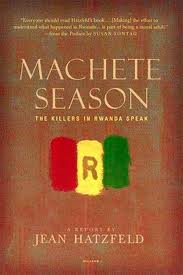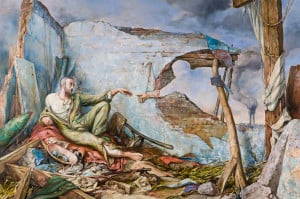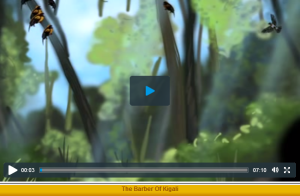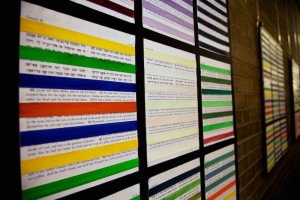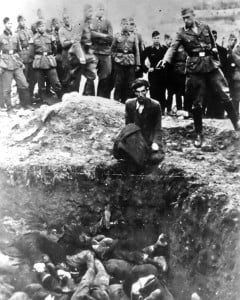After a year of learning about Genocide and Crimes Against Humanity, students gravitate towards complex and profound questions that are increasingly difficult to answer. In a setting that involves teaching at-risk youth, this type of engagement can be frustratingly elusive. The lesson (content wise) that I will share with you today is one that should not stand alone. This took place in class after having done 3 case studies, including Rwanda, and a unit on concepts of Justice and Memorial. I found that this lesson was very successful at engaging students of all stripes through particular stories of perpetrators to try to gain a better understanding of universal questions of guilt, responsibility, reconciliation, and justice.
Topics: Facing History Resources, History, Urban Education, Strategies, genocide, Genocide and Crimes Against Humanities Course, Lesson Ideas, big paper, CHG
I was recently very fortunate to be invited to join a trial UDHR Glogster project with Facing History (see samples of student work). The purpose of the project was to have students complete a project about the Universal Declaration of Human Rights using Glogster.
In this project, we, the teachers, were given tutorials in the application of Glogster.
Topics: Technology, Strategies, Glogster, Lesson Ideas
Making Breakthroughs: Using Spoken Word Poetry to Teach History
Posted by Jasmine Wong on April 22, 2013
An innovative new collaboration taking place in Canada this spring is connecting classrooms and teaching students literacy and performance skills through the study of history and spoken word poetry. “Stand Up, Speak Out,” a four-week program designed by Facing History and Ourselves, is bringing professional spoken word artists into Grade 11 classrooms as part of a unit of study that explores the history of genocide and issues of identity, tolerance, and community.
Topics: Genocide and Crimes Against Humanities Course, Lesson Ideas, Literature
Where was God during the Shoah? Jewish students seek answers in Art and Tradition
Posted by Jack Lipinsky on April 21, 2013
One of my most powerful childhood memories is seeing "The Ten Commandments" in the original "Cinemascope" at the now demolished Glendale Cinema on Avenue Road. I never forgot the grandeur of the huge screen especially in scene where Moses (Charlton Heston) epically raised his arms with the Rod of God aloft, and the sea crashed down upon the pursuing Egyptians while Pharaoh (Yul Brynner) gasped in awe and said: "The Lord is God." So much for nostalgia. I wonder what Moses would have said watching a synagogues of Germany burn down on Kristallnacht when firefighters stood idle and crowds gathered to gawk? He might well have asked, as do my students, "where was God"?
Topics: History, Holocaust Education, Lesson Ideas
7 Great Little Viral Videos for the Facing History Classroom
Posted by Michael Grover on April 13, 2013
The Facing History resource “Pigeon” demonstrates the impact a short film can have. Set amid the tension of occupied Europe during World War II, it is an example of the power an individual has to make a difference, if they choose to do so. A viral video is a video that results from online distribution and sharing, an excellent route to engaging our students. Finding short videos online is, therefore, a powerful teaching strategy.
Video clips are accessible to many learning styles, and of particular value when teaching the applied and essential level student. As ‘clips’, they are brief, thus benefiting shorter attention spans and working well in the structure of the 3-part lesson for the 75 minute classroom. They are easily shared if a student is absent (unlike a film) and easily re-watched (either individually or collectively) without generating a great burden on classroom time, which is so precious. And they play to the sensibilities of the digital generation (which in turn allows us as teachers to create the pretense to a shared sense thereof).
Topics: Facing History Resources, videos, Strategies, Lesson Ideas
One of the challenges many teachers experience is trying to meet the needs of their diverse student population in their respective classes. Differentiated instructions strategies (D.I.) enables teachers to better meet these varied needs and in turn enables students to be successful because their needs are met at their level of readiness, interests and learning styles.
Topics: History, Middle School, Strategies, Lesson Ideas, English Classroom, Literature
Collaborative Inquiry using NIGHT: An Interview with Professor Rob Simon
Posted by Jasmine Wong on April 8, 2013
In this interview, we asked Rob Simon, Assistant Professor of Multiliteracies in Education at OISE/University of Toronto (Dept of Curriculum, Teaching and Learning), to tell us more about the Teaching to Learn Project so we could better understand how and why collaborative (teacher-adolescent) curriculum planning worked, why he chose Elie Wiesel's Night as the study text, and where he got the idea to ask project participants to paint on the pages of the text as a form of reading response.
The images below are the culmination of those responses, which were mounted in an exhibition titled After Night.
Topics: Facing History Resources, Innovative Classrooms, Holocaust Education, Lesson Ideas, English Classroom
"The Last Jew in Vinnitsa": How Media provides a way to understand Perpetrators/Bystanders/Victims
Posted by Jack Lipinsky on April 7, 2013
Graphic imagery is used in this lesson. Please read the full post before teaching this.
I start by displaying the famous photo called "The Last Jew in Vinnitsa."
I say, "This was the title given by the Einsatzgrup soldier in whose pocket it was found, scribbled on the back. Vinnitsa is a small town in the Ukraine whose entire Jewish population was wiped out by the Einsatzgruppen mass killing methods in 1941."
This is all I tell my students when displaying this picture. They have already learned about the Einsatzgruppen and read the selection on "Battalion 101" in Holocaust and Human Behaviour Chapter 7 Reading 3 . They have also been taught that there are three groups involved in genocide: perpetrators, bystanders, and victims.
Topics: History, The Last Jew in Vinnitsa, genocide, Genocide and Crimes Against Humanities Course, Lesson Ideas, reflection
Using Visual Media to Learn about Genocide--OR--Goodbye "boring" History classes
Posted by Jack Lipinsky on April 7, 2013
In my last post I noted how saturated our students are by visual media. What a sharp contrast their lives are with mine at their age. In my high school history classes, the walls were adorned with old men, mostly with mutton chop whiskers and beards, staring down at me. Each of them had their name, dates of birth and death, and a sour stare that intimidated me when I glanced at them. My teachers reverently cited these old mens' careers and quoted them to the point of endless boredom.
Topics: History, Middle School, Strategies, Genocide and Crimes Against Humanities Course, Lesson Ideas

